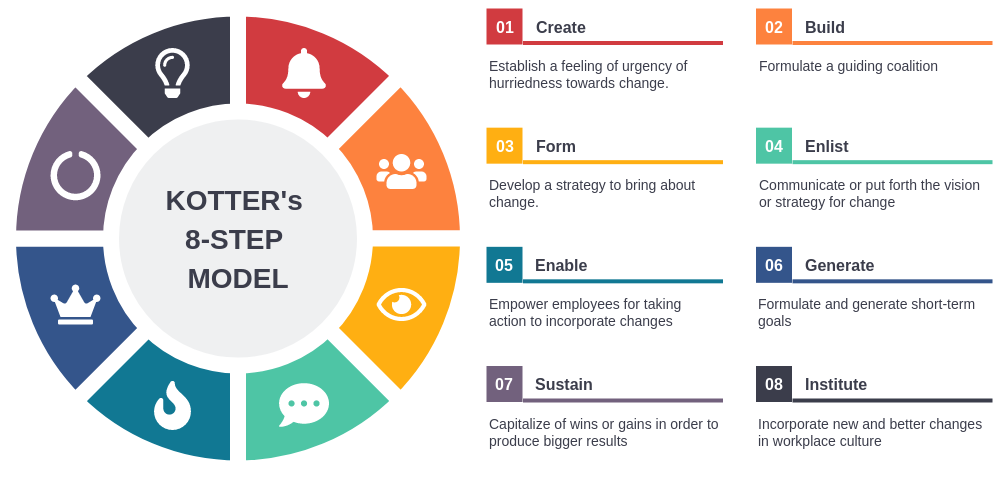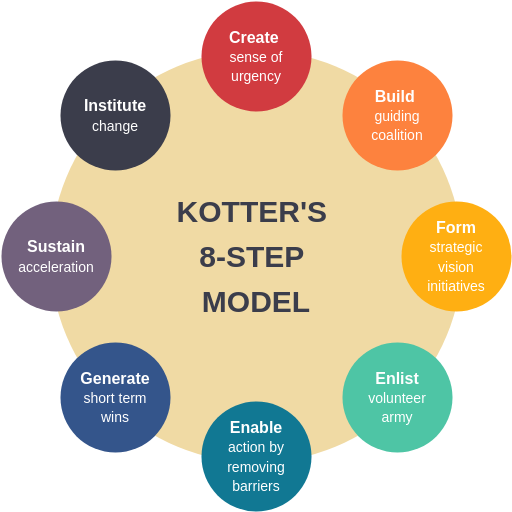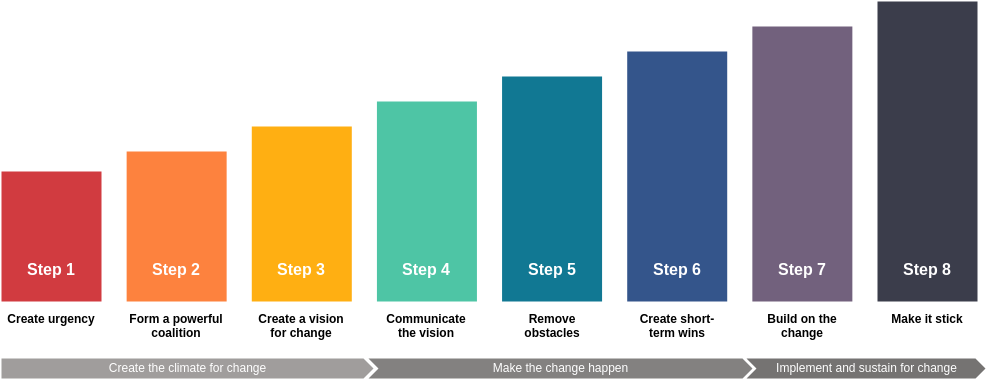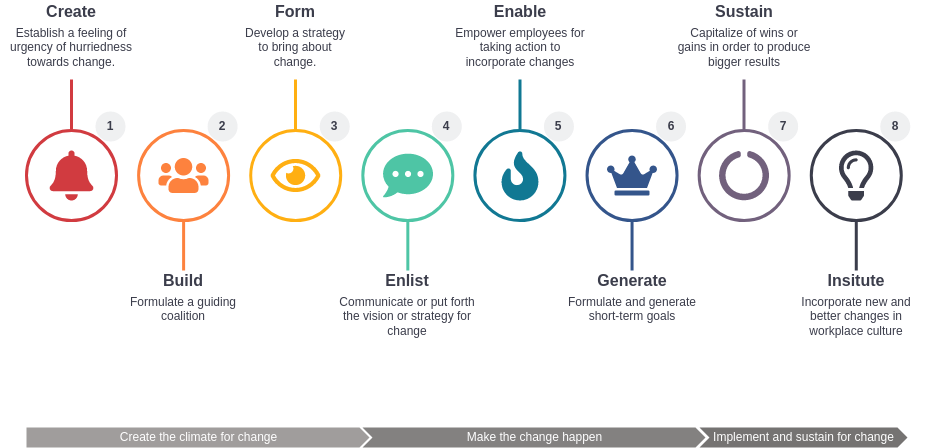Kotter’s 8 Step Change Model – A Comprehensive Guide
John Kotter, the American change management guru and a professor at Harvard Business School, has proven through long-term research that the success rate of major organizational change in companies is only 30%. He proposed “Kotter’s 8-step change model“, saying that if companies follow this 8-step plan, they can improve their organizational change capabilities and increase their chances of success.
Kotter’s 8 Step Change Model
The 8 steps in the process of change include: creating a sense of urgency, forming powerful guiding coalitions, developing a vision and a strategy, communicating the vision, removing obstacles and empowering employees for action, creating short-term wins, consolidating gains and strengthening change by anchoring change in the culture. Kotter’s 8 step model can be explained with the help of the illustration given below:

1. Create a sense of urgency – According to Kotter, the first step is the most important one. To make employees aware of the need and urgency of organizational change, managers must have an open, honest, and convincing dialogue with employees to gain their support for change.
2. Build guiding team – This is another way to build a change leadership team. Team members are responsible for managing all change efforts and encourage a constructive approach by all employees in the company. Team members should ideally come from different departments and at different levels so that the change leadership team can communicate effectively with employees from different departments.
3. Develop a strategic vision and initiatives – Having a clear vision helps each employee understand what the organization wants to achieve and what plans to implement within a given time frame. Managers need to keep the execution strategy consistent with the company’s vision to help employees achieve their goals.
4. Communicate the change vision – This step is to build employees’ support and acceptance of organizational change. Managers must continually take the opportunity to communicate the new vision with employees and take seriously their feedback and anxiety about the change.
5. Enable action by removing barriers – Managers need to remove any barriers to organizational change, whether they are employees who are resistant to change or ineffective internal systems. At the same time, managers need to encourage employees to take risks and innovative actions.
6. Create short-term wins – There is nothing more motivating than success. Managers can establish short-term goals, and when employees achieve them, they can reward them for their participation in the change process. The benefit of this is that it gives the entire company more motivation to make changes and makes everyone understand that the company is going through a transformation phase.
7. Sustain acceleration – Kotter observed that many changes fail because companies declare success too early, but change is a slow process. The short-term goals established in the previous step are only short-term victories, and the company must continue to adjust the new plan until the vision is realized before the company can be sure that the organizational change is successful.
8. Anchor new approaches in the culture – Managers clearly communicate to employees the causal relationship between new change behaviors and organizational success, and continue to support change behaviors and reinforce the spirit of change as part of the corporate culture.
ExampleThe 8 Steps of Kotter’s Change Model
The fundamental challenge of the 8 Steps of Kotter is not in the system or strategy, but in changing the behavior of people. Therefore, in the first four steps, managers must patiently communicate with employees until all employees understand the challenges and reasons for change, and then they can move forward smoothly.
Pepsi.co: a classic example:
Indra Nooyi, the former CEO of PepsiCo, had always believed that PepsiCo had to change, and in 2006, she reorganized the company’s global strategy by acquiring Tropicana, Quaker Oats, and Gatorade.
But the most controversial change in strategy was to improve the nutritional profile of PepsiCo’s products by reducing the resources devoted to junk food production and adding more healthy products. She reorganized PepsiCo’s products into three categories: 1.
- Fun for you
- Better for you
- Good for you (Healthy choices)
Using Kotter’s 8 Steps to Change, Indra Nooyi communicated her vision for change to all employees.
- Create a sense of crisis about the urgent need for change: Lloyd made sure that employees understood that PepsiCo must produce healthier products now that consumers are taking their health seriously because of the growing problem of obesity.
- Build a team to lead the change: Lloyd convened a meeting with management to discuss organizational change and the need to move toward healthier products.
- Develop a vision and strategic plan: In her Performance with Purpose statement, she declared a clear vision to all employees for a healthier company.
- Communicating the vision for change: Through continuous discussions with all employees about change and vision, Lloyd makes the need for change clear to the entire organization.
- Removing barriers: She also identifies potential barriers to change, removes them, and continually expresses a new company vision.
- Generating “Short-Term Wins”: As Elaine Lo once said, “When managing a large corporation, it is critical to balance long-term and short-term plans. She takes short-term wins very seriously and uses them as a way to motivate her employees.
- Consolidate results and improve: PepsiCo has said that one of the company’s goals is to “continue to improve our food and beverage choices, reduce sodium, sugar, saturated fat and develop a more diverse portfolio of products to meet changing consumer needs.
- Embedding the spirit of change in our corporate culture: In an interview, Lloyd said, “Make products that are healthy and taste better, so that consumers don’t have to compromise on tasty food for the sake of health. That’s the strategy PepsiCo is following.
The company has successfully transformed PepsiCo into a brand with the impression of healthy products, and this spirit of change has been deeply rooted in the minds of consumers and employees through interviews and continuous publicity.
More Kotter’s Change Model Example and Template (Provided by Visual Paradigm Online)







